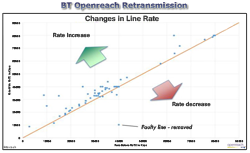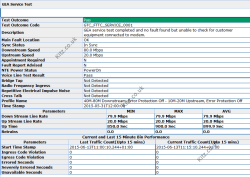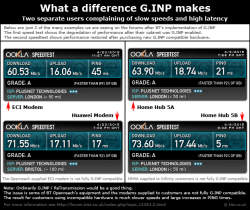~ Introduction to G.INP
G.INP offers effective protection against Impulse Noise in order to improve line stability. It also reduces overheads and latency when compared to traditional methods of interleaving and RS Error Correction.
~ G.INP by another name
G.INP may also be known as:
- Retransmission or ReTX - How BT refer to it.
- PhyR - Broadcom's proprietary name and trademark for the invention. Originally only available on Broadcom devices. Pronounced "Fire".
- G.998.4 - The ITU name for the technology which was standardised & approved in 2010.
~ What is G.INP / Retransmission?
All DSL lines suffer at various degrees from noise bursts. This interference may come from electric storms, power supplies, radio transmissions or just general background electrical interference. This noise can drown out the signal which is used to transmit your broadband data. - See SNR.
If the noise is stronger than the signal, then data packets are lost which can cause slow page loading or interrupted video streams etc.
G.INP is an Error Protection method which helps prevent the loss of data in the event of noise bursts by using a retransmission buffer at the physical layer. (In the Modem/Router/DSLAM).
G.INP retransmission works in a similar way to TCP retransmission, notable differences between the two are:
- TCP/IP is a software suite of protocols between two end to end points.
eg Web browsers such as IE & Firefox use the TCP/IP protocol HTTP to establish a connection between out PC and a remote web server. If data isn't received or is corrupt, then the web browser will attempt to re-request the data direct from the server.
- G.INP is a software construct carried out at the physical layer.
eg Data sent from the DSLAM is wrapped in a special packet (DTU). The router will check that data isn't corrupt and then either forward the data onwards to our PC, or if corrupt re-request the data from the DSLAM. The transmitting end needs to retain a temporary buffer to store data in case data needs to be retransmitted.
Although G.INP as an invention has been around for several years and it is a software construct (ie firmware), many Telco's delayed rollout as it relies on hardware resources to process the DTU and store data in the retransmission buffer at the transmitting end.
Bearing in mind that the DSLAM will be doing ReTX buffering downstream direction and will have many users on each line card in the DSLAM then downstream retransmission will require significant hardware resource by the DSLAM.
It is the modem/router that is responsible for upstream DTU and buffering for G.INP.
If the modem for some reason is incapable of upstream DTU, then (depending upon chipset) it is possible to update the firmware so that it can simply acknowledge safe receipt of data (RRC) in the downstream direction only.
~ What are the benefits of G.INP / Retransmission?
- Traditional methods of Error Protection such as RS encoding / FEC constantly transmits redundant data so that in the event of noise burst, data can be recovered. The downside of Forward Error Correction is this redundant data is an overhead that can substantially reduce the line rate and available sync speed for transmission of useful data by 10% or more.
With G.INP these data overheads are incurred only when retransmitted data is being requested and re-sent.
- Because retransmission of corrupt data is done at the physical layer directly between the DSLAM and modem, the delay will obviously be less than having to re-request data from a server which may be located on the other side of the globe. Typical delay for G.INP re-request is 2ms per direction.
Broadcom claims that retransmission technology provides up to ten times higher impulse noise resilience and significantly lower residual BER or packet-loss.*
~ How does G.INP / Retransmission work?
- Outgoing data is copied and encapsulated in DTUs (Data Transfer Units) or retransmission units.
- The DTUs are stored in a retransmission queue buffer.
- Original data packets are sent over Bearer Channel 0 as normal.
- Receiving end checks data for corruption as normal using frame check sequence (FCS).
- In the event of data loss a retransmission request is sent over the Retransmission Request Channel (RRC).
- Upon receipt of a re-request, the transmitting modem/DSLAM will retrieve the relevant DTU and resend the data.
- If retransmitted data (DTUs) do not arrive on time then higher level error correction will be undertaken as usual (eg CRC recorded).
It is possible to apply different levels of INP to Bearer 0 and Bearer 1. ie FEC can be independently used on Bearer 0.
~ Will G.INP give me more line speed?
That will entirely depend on your pre-G.INP DLM profile and line condition. If the DLM had previously applied Interleaving and Error Correction then there is a good chance that it will.
The graph on the right shows a sample of line rate changes recorded during Openreach trials of retransmission. The further away from the red line, the greater the sync speed increase (or decrease). |
|
If however your line ran happily without any DLM intervention, then no it won't increase your line rate. G.INP can only give back some of the speed previously taken away by Error Correction overheads and Interleave delay.
Retransmission works well with Vectoring which will bring speed increases and more lines will be running at their maximum capability. |
~ Is G.INP similar to Vectoring?
No the two are different beasts, but they can be used in tandem.
- Vectoring is a noise cancellation technique for crosstalk (self-FEXT). Cross-talk is signal leakage of an adjacent pair and is a constant stationary source of interference whilst the line is in use. Vectoring is a method which controls and processes the DSL signal in a way which mitigates self injected crosstalk. The result is higher achievable sync rates due to improved SNR.
- G.INP is a method of data recovery in the event of noise bursts. It works well for REIN impulse noise, but can't help stationary noise such as FEXT. G.INP is more of an after event that has no impact on SNR and therefore unable to improve sync speed. Retransmission can only give back any sync speed previously lost through RS encoding overheads (Error Correction).
~ How are Openreach rolling out G.INP / Retransmission?
As far as the EU is concerned then roll out involves a 2 part process:-
- Stage one is upgrading the firmware in their local cabinet. This usually involves a short period of downtime of circa 5 mins.
- Stage two is applying a retransmission profile to the line via the DLM system. This will cause the line to automatically resync to pick up the new profile. This is being done at a rate of circa 45k lines per night.
Openreach commenced rollout to their Huawei cabinets in January 2015. The first lines with G.INP profiles started appearing in Feb 2015. At the time of writing no ECI cabs other than those on the test pilot are enabled.
kitz.co.uk was the first website to notify users that Openreach was rolling out G.INP. We have also dedicated G.INP thread for discussion of the rollout on our forums.
~ How can I tell if G.INP / Retransmission has been applied to my line?
If your line was enabled before March 2015 and you are connected to a Huawei cabinet then you likely to already have G.INP enabled. There are a few exceptions such as newly enabled lines and those which have had a DLM reset.
If you have access to your modem router line stats, clues to look out for are the use of Bearer 1 in addition to Bearer 0. The INP value on a G.INP line will usually be 46+ compared to 3+ on a line which doesn't have retransmission. You may also see other values such as rtx counters and LEFTRS. |
|
Your ISP should also be able to tell by performing a GEA Service Test to get your DLM profile:
- The following is an example of a line which has G.INP applied:-
Profile Name 0.128M-80M Downstream, Retransmission Low - 0.128M-20M Upstream, Retransmission Low
- The following is an example of a line without G.INP:-
Profile Name 40M-80M Downstream, Error Protection Off - 10M-20M Upstream, Error Protection Off
|
~ What went wrong with the Openreach rollout of G.INP / Retransmission?
Soon after rollout it became apparent that whilst most lines weren't experiencing any issues, there were some lines which were suddenly seeing the loss of circa 10Mbps of speed and large increases of latency (ping times).
The increase in latency caused issues with VoIP and online gaming.
At first both the ISPs and Openreach were in denial that there was an issue. kitz was the first to identify that those lines with problems were all using equipment with a Lantiq VRX-268 chipset which didn't fully support g.inp. This list includes the ECI modem, BT Homehub 5A and the TP-Link TD-W9980 |
|
At the end of March Openreach suspended rollout and commenced working on a fix.
We also worked closely with TP-Link who were pro-active in releasing new firmware for the TD-W9980. |
~ What was the problem and how did Openreach fix it?
Certain equipment is not compatible with g.inp on the upstream. Those modems which can't do upstream G.INP were given a default profile that applied a high level of interleaving and Error Correction.
It was this high level of interleaving which caused the large increase in latency and Error Correction reduced the amount of available sync speed.
The fix applied by Openreach was a less harsh default profile for the upstream which doesn't have interleaving applied for those modems which aren't fully G.INP compatible.
~ What is G.INP Mk2?
Technically speaking there isn't actually such a thing nor product. The term G.INP Mk2 was born on the kitz forums simply as a way to identify those lines that had the Openreach fix applied.
~ What are the available options for DLM profiles?
These are the available configurable options:-
- Downstream:
[Speed band], Error Protection Off, ReTx Low, ReTx High, Interleaving Low, Interleaving High.
- Upstream:
[Speed band], Error Protection Off, ReTx Low, ReTx High, Interleaving On.
Although there is a downstream option for Error Correction off, this only applies to open profiles or non G.INP lines. For G.INP lines ReTx Low will be the de facto for downstream and move through other profiles depending upon stability. Note that if Interleaving is applied, then INP Error Correction will also be turned on at the same time.
After a DLM reset the initial profile is: -
Downstream: Interleaving (& INP) Low. Upstream: Interleaving Off.
If the DLM identifies that the line can support Retransmission, then ReTx Low will be automatically applied to the downstream after a couple of days.
~ Which modems aren't G.INP compatible or unable to perform upstream retransmission?
We maintain a list of these modems on the forums. Broadly speaking most of the modern VDSL modem/ routers are fully G.INP compatible and capable of both downstream and upstream Retransmission.
The main exceptions are BT HomeHub Type 5A, Openreach ECI modem and Draytech Vigor 2850 series.
Since Openreach applied their fix, the 'G.INP Mk2' solution is a much fairer all round situation regardless of modem equipment. Upstream retransmission is still there for lines which experience noise and are using a compatible modem, but lines without compatible equipment aren't as heavily speed penalised like with v1.
If you are looking for a modem/router to replace your ECI modem we were originally advising users to purchase a Huawei modem from the likes of eBay.
However, please be cautious and don't pay extortionate prices.
Prior to G.INP these could be picked up for about £10 but unfortunately some sellers are marking these up to silly prices (£80-90) and making false claims about their performance.
As a guide you should not pay more than £20 for a locked unit or £40 at the very most for an unlocked unit. |
|
Remember these will be second hand units and if you pay much more than that, it may be more economical to purchase a brand new modem with full manufacturers support. Please ask on our forums if in doubt or if you need help.
Information how to unlock the HG612 for free is available on the following pages:
The G.INP B030SP08 firmware was written kitz member Howlingwolf and is also free to download, as are the other support tools provided by members of our community. |
References & Further Reading:
BT Openreach - Questions about G.INP
TCP Retransmission
ITU-T G.998.4
PhyR™ Retransmission System Overcomes ADSL Challenges
©kitz Aug 2015
|






